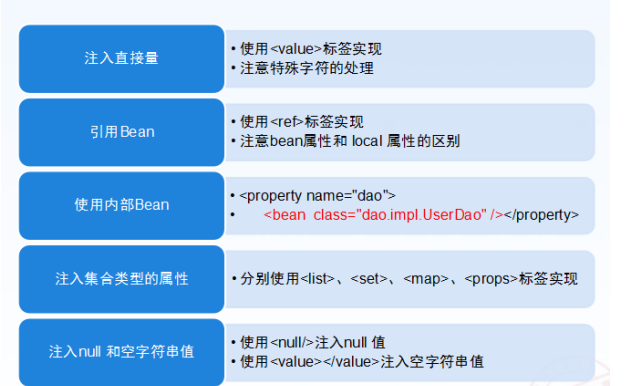1.构造注入
Spring提供了多种依赖注入的手段,除了通过属性的setter访问器,还可以通过带参构造方法实现依赖注入
注入Bean属性---构造注入配置方案
在Spring配置文件中通过<constructor-arg>元素为构造方法传参
注意:
1、一个<constructor-arg>元素表示构造方法的一个参数,且使用时不区分顺序。
2、通过<constructor-arg>元素的index 属性可以指定该参数的位置索引,位置从0 开始。
3、<constructor-arg>元素还提供了type 属性用来指定参数的类型,避免字符串和基本数据类型的混淆。
在实体类中声明一个带参的构造
public HappyService(String info, Integer age) { this.info = info; this.age = age; }
在xml文件中用构造注入的方式赋值
<!--构造赋值-->
<bean id="service" class="happy.HappyService">
<constructor-arg index="0" value="周永琪"></constructor-arg>
<constructor-arg index="1" value="18"></constructor-arg>
</bean>
使用p命名空间注入属性值
1.创建实体类
public class Student { private String name; private Integer age; private Car car; public Car getCar() { return car; } public void setCar(Car car) { this.car = car; } public Integer getAge() { return age; } public void setAge(Integer age) { this.age = age; } public String getName() { return name; } public void setName(String name) { this.name = name; } }
2.xml节点中赋值
xmlns:p="http://www.springframework.org/schema/p" 引入P标签
<!-- P命名空间赋值 --> <bean id="Student" class="happy.Student" p:name="张毅" p:age="18" p:car-ref="cars"> </bean>
<bean id="cars" class="happy.Car"> <property name="color" value="蓝色"></property> <property name="brand" value="布加迪威龙"></property> </bean>
注入不同数据类型 list,Set,Map,Properties,String[]

public String[] array; public List<String> list; public Set<String> set; public Map<String,String> map; public Properties properties;
<bean id="mycollection" class="MyCollection.collection" scope="prototype"> <property name="array"> <array> <value>青鸟杯</value> <value>世界杯</value> <value>苹果派</value> </array> </property> <property name="list"> <list> <value>程序员</value> <value>分析师</value> <value>架构师</value> </list> </property> <property name="set"> <set> <value>李白</value> <value>韩信</value> <value>妲己</value> </set> </property> <property name="map"> <map> <entry key="Y2167"> <value>面试题</value> </entry> <entry key="Y2166"> <value>青鸟杯</value> </entry> <entry key="S2229"> <value>多线程</value> </entry> </map> </property> <property name="properties"> <props> <prop key="1">第一名</prop> <prop key="2">第二名</prop> <prop key="3">第三名</prop> </props> </property> </bean>